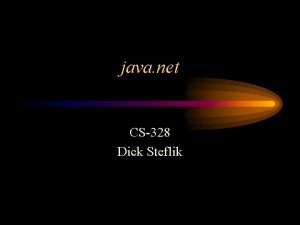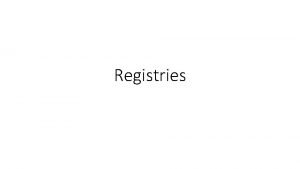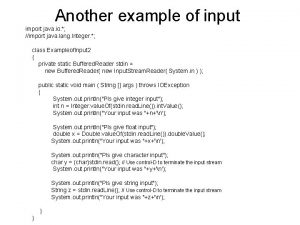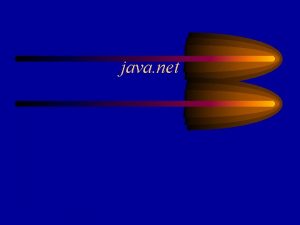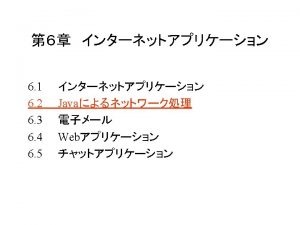java net CS328 Dick Steflik Inet Address Class












![Datagram. Packet Class – Datagram. Packet(byte[] buf, int len, Socket. Address addr) • Constructs Datagram. Packet Class – Datagram. Packet(byte[] buf, int len, Socket. Address addr) • Constructs](https://slidetodoc.com/presentation_image_h/909518ee98413fe06723e14878352ab7/image-13.jpg)








![URL Class - Methods Getters String get. Authority( ) Object get. Content(Classes[ ] classes) URL Class - Methods Getters String get. Authority( ) Object get. Content(Classes[ ] classes)](https://slidetodoc.com/presentation_image_h/909518ee98413fe06723e14878352ab7/image-22.jpg)










- Slides: 32

java. net CS-328 Dick Steflik

Inet. Address Class • The Inetaddress class provides you with a limited interface to DNS for doing both forward and reverse internet address lookups – An Inet. Address class method corresponds to a DNS request

Inet. Address Class • No public constructor • Three static methods: – Inet. Address get. By. Name(String) • Static method used to retrieve the address for the host name passed as the parameter. – Inet. Address [ ] get. All. By. Name(String) • Static method used to retrieve all the addresses for the host name passed as a parameter. – Inet. Address get. Local. Host( ) • Static method used to retrieve the address for the current, or local, host.

Inet. Address Class • Three additional “getter” methods – String get. Host. Name( ) • Returns the host name. – byte[ ] get. Address( ) • Returns the IP address. – String get. Host. Address( ) • Returns the IP address as a string.

Inet. Address Examples try { Inet. Address fullname = net. Address. get. By. Name(“bigyellowcat. cs. binghamton. edu"); Inet. Address alias = Inet. Address. get. By. Name(“bigyellowcat"); Inet. Address octets = Inet. Address. get. By. Name(“ 128. 226. 121. 44"); if (fullname. equals(alias) && fullname. equals(octets)) // All is right with the world! } catch (Unknown. Host. Exception e) { // Exception handling here. }

TCP Sockets • Once a TCP socket connection is made, a virtual stream is in place. Java’s IO model is that of a stream, therefore the models are consistent; all you need to do connect a TCP socket to a stream and read and write the streams as normal

Socket Class - TCP Client sockets • Socket(String ip, int port) – Creates a streaming socket and binds it to the host and port specified as parameters. • Socket(String ip, int port, boolean TCPor. UDP) – Creates a socket and binds it to the host and port specified as parameters. The last parameter is used to indicate whether the socket should be a stream or datagram socket. • Socket(Inet. Address ia, int port) – Creates a streaming socket connected to the specified host and port. • Socket(Inet. Address ia, int port, boolean TCPor. UDP) – Creates a socket connected to the specified host and port. The last parameter specifies whether the socket should be a stream or datagram socket.

Client Sockets • Inet. Address get. Inet. Address( ) – Returns an Inet. Address object representing the host for this socket. • Int get. Port( ) –. Returns the port number on the remote host for this socket • Int get. Local. Port( ) – Returns the port number on the local host for this socket. • Input. Stream get. Input. Stream( ) – Returns an input stream for the socket. • Output. Stream get. Output. Stream( ) – Returns an output stream for the socket. • Close( ) – Closes the socket. • Set. Socket. Impl. Factory (Socket. Impl. Factory) – Sets the socket factory that will be used to create all sockets.

Reading and Writing try { Socket socket = new Socket("somehost. somewhere. com", -1); // Always a good idea to buffer the stream to mitigate blocking. Print. Stream out = new Print. Stream( new Buffered. Output. Stream(socket. get. Output. Stream())); out. println("Are you listening? "); Data. Input. Stream in = new Data. Input. Stream( new Buffered. Input. Stream(socket. get. Input. Stream())); in. read. Line(); //. . . // Don't forget to close the socket! socket. close() } catch (Exception e) // Exception handling logic.

Examples • See Day. Time. Client and Echo. Client on web site

UDP Sockets • Since UDP is a connectionless protocol; there is no virtual stream between the hosts so streams are not used for IO. • UDP applications are not thought of in terms of clients and servers, but rather in terms of senders and receivers. – For conversational applications both ends (sender and receiver) will be changing states from sender to receiver and back again – Many UDP based applications are simple send a request then receive the data (sender’s perspective), like a DNS request. The receiver’s perspective is to ‘listen’ for a request, send the response, listen for more requests.

Datagram. Packet Class • UDP sockets send and receive Datagrams • Constructors: two for receiving, four for sending – Datagram. Packet( byte[ ] buff , int len) • Constructs a Datagram. Packet for receiving packets of length len. – Datagram. Packet(byte[] buf, int off, int len) • Constructs a Datagram. Packet for receiving packets of length len, specifying an offset of off bytes into the buffer. – Datagram. Packet((byte[] buf, int len, Inet. Address addr, int port) • Constructs a datagram packet for sending packets of length len to the specified port number on the specified host. – Datagram. Packer(byte[] buf, int off, int len, Inet. Address addr, int port) • Constructs a datagram packet for sending packets of length len with offset off to the specified port number on the specified host. – Datagram. Packet(byte[] buf, int off, int len, Socket. Address addr) • Constructs a datagram packet for sending packets of length len with offset off to the specified port number on the specified host.
![Datagram Packet Class Datagram Packetbyte buf int len Socket Address addr Constructs Datagram. Packet Class – Datagram. Packet(byte[] buf, int len, Socket. Address addr) • Constructs](https://slidetodoc.com/presentation_image_h/909518ee98413fe06723e14878352ab7/image-13.jpg)
Datagram. Packet Class – Datagram. Packet(byte[] buf, int len, Socket. Address addr) • Constructs a datagram packet for sending packets of length len to the specified port number on the specified host. Getter methods Setter methods get. Address( ) set. Address(Inet. Address iaddr) get. Data( ) get. Length( ) get. Offset( ) get. Port( ) get. Socket. Addr ess( ) set. Data(byte[ ] buf) set. Data(byte[] buf, int offset, int length) set. Length(int len) set. Port(int port) set. Socket. Address(Socket. Addres s saddr)

Datagram. Socket Class – UDP Sockets • Constructors – Datagram. Socket() • Constructs a datagram socket and binds it to any available port on the local host. – Datagram. Socket(Datagram. Socket. Impl impl) • Creates an unbound datagram socket with the specified Datagram. Socket. Impl. – Datagram. Socket(int port) • Constructs a datagram socket and binds it to the specified port on the local host. – Datagram. Socket(int port, Inet. Address iaddr) • Creates a datagram socket, bound to the specified local address. – Datagram. Socket(Socket. Address bindaddr) • Creates a datagram socket, bound to the specified local socket address.

Datagram. Socket Class – operational Methods • Operational (void) Methods – bind(Socket. Address addr) – connect(Inet. Address address, int port) – connect(Socket. Address addr) – disconnect( ) – receive(Datagram. Packet p) – send(Datagram. Packet p) – close( )

Datagram. Socket Class – getter methods Getter Methods: Datagram. Channel get. Channel( ) Inet. Address get. Inet. Address( ) boolean get. Broadcast( ) Inet. Address get. Local. Address( ) int get. Local. Port( ) Socket. Address get. Local. Socket. Address( ) Socket. Address get. Remote. Socket. Address( ) int get. Port( ) int get. Receive. Buffer. Size( ) int get. Send. Buffer. Size( ) boolean get. Reuse. Address( ) int get. So. Timeout( ) int get. Traffic. Class( )

Datagram. Socket Class – setter methods Setter Methods: void set. Broadcast( boolean on) static void set. Datagram. Socket. Impl. Factory (Datagram. Socket. Impl. Factory fac) void ser. Receive. Buffer. Size(int size) void set. Reuse. Address(boolean on) void set. Sevd. Buffer. Size(int size) void set. So. Timeout(int timeout) void set. Traffic. Class(int tc)

Datagram. Socket Class – test methods Test Methods: boolean is. Bound( ) boolean is. Closed( ) boolean is. Connected( )

Datagram Sockets Examples • See examples on web site

URL Class • RFC 2396 • essentially a “pointer” to a resource on the World Wide Web – different services use slightly different formats • file: //ftp. yoyodyne. com/pub/files/foobar. txt • http: //www. yahoo. com/index. html • ftp: //useracct@someftpserver. com • news: rec. gardening • gopher: //gopher. banzai. edu: 1234/

URL Class - Constructors • URL(String spec) – Creates a URL object from the String representation. • URL(String protocol, String host, int port, String file) – Creates a URL object from the specified protocol, host, port number, and file. • URL(String protocol, String host, int port, String file, URLStream. Handler handler) – Creates a URL object from the specified protocol, host, port number, file, and handler. • URL(String protocol, String host, String file) – Creates a URL from the specified protocol name, host name, and file name. • URL(URL context, String spec) – Creates a URL by parsing the given spec within a specified context • URL(URL context, String spec, URLStream. Handler handler) – Creates a URL by parsing the given spec with the specified handler within a specified context.
![URL Class Methods Getters String get Authority Object get ContentClasses classes URL Class - Methods Getters String get. Authority( ) Object get. Content(Classes[ ] classes)](https://slidetodoc.com/presentation_image_h/909518ee98413fe06723e14878352ab7/image-22.jpg)
URL Class - Methods Getters String get. Authority( ) Object get. Content(Classes[ ] classes) int get. Default. Port( ) String get. File( ) String get. Host( ) String get. Path( ) int get. Port( ) String get. Protocol( ) String get. Query( ) String get. Ref( ) String get. User. Info( )

URL Class - Methods Setters set(String protocol, String host, int port, String file, String ref) set(String protocol, String host, int port, String authority, String user. Info, String path, String query, String ref) set. URLStream. Handler. Factory(URLStream. Handler. Factory fac)

URL Class – Utility methods int hash. Code( ) URLConnection open. Connection( ) Input. Stream open. Stream( ) boolean same. File(URL other) String to. External. Form( ) String to. String( ) boolean equals(Object obj)

URL Class - example • see Read. URL example on web site

Server. Socket • Used as the main connection point for some service you wish to provide. • Once created, it listens for connection requests then queues the request for disposition • On Unix/Linux you must be root to use

Server. Socket – Life cycle • A new Server. Socket is created on a particular port using a Server. Socket( ) constructor. • The Server. Socket listens for incoming connection attempts on that port using its accept( ) method. accept( ) blocks until a client attempts to make a connection, at which point accept( ) returns a Socket object connecting the client and the server. • Depending on the type of server, either the Socket's get. Input. Stream( ) method, get. Output. Stream( ) method, or both are called to get input and output streams that communicate with the client. • The server and the client interact according to an agreed-upon protocol until it is time to close the connection. • The server, the client, or both close the connection. • The server returns to step 2 and waits for the next connection.

Server. Sockets - threads • Simultaneous requests are held in a queue, as each request is removed from the queue and processed new connections requests can be added to the queue. Connection requests received while the queue is full will be blocked. – Some clients use multiple retries in this case as queue space will usually open up pretty quickly. • For simple protocols (Day. Time) the queue can usually handle all of the requests without problem • For more complex protocols (HTTP) use a thread to process each connection. Threads have less overhead than spawning an entire child process.

Server. Socket - Constructors • public Server. Socket(int port) throws IOException, Bind. Exception • public Server. Socket(int port, int queue. Length) throws IOException, Bind. Exception • public Server. Socket(int port, int queue. Length, Inet. Address bind. Address) throws IOException

Server. Socket – methods • accept( ) – accepts a connection request and creates a socket to the remote user • close( ) – close the server socket and wait for next connection request

Server. Socket - example Server. Socket server = new Server. Socket(5776); while (true) { Socket connection = server. accept( ); Output. Stream. Writer out = new Output. Stream. Writer(connection. get. Output. Stream( )); out. write("You've connected to this server. Bye-bye now. rn"); connection. close( ); }

Server Sockets - problems • You are not root • Port is already in use
 Dick van dyke dick tracy mary poppins
Dick van dyke dick tracy mary poppins Cs328
Cs328 Cs328
Cs328 Logical memory is broken into
Logical memory is broken into Inet wellspan
Inet wellspan Wellspan inet
Wellspan inet Inet infotech pvt ltd
Inet infotech pvt ltd Inetmuni
Inetmuni Inet org person
Inet org person Inet
Inet Inet carsales
Inet carsales Inet ecn
Inet ecn Class b ip address example
Class b ip address example Class d and e ip address
Class d and e ip address Java import java.util.*
Java import java.util.* Java import java.util.*
Java import java.util.* Import java.applet.applet
Import java.applet.applet Import java util
Import java util Import java.io.*
Import java.io.* Java gcd
Java gcd Java import java.util.*
Java import java.util.* Import java.io.* in java
Import java.io.* in java Import java.util
Import java.util Java import java.io.*
Java import java.io.* Perbedaan antara java swing dan awt adalah
Perbedaan antara java swing dan awt adalah Import java.awt.* import java.awt.event.*
Import java.awt.* import java.awt.event.* Language
Language What is rmi and ejb in java
What is rmi and ejb in java Java net package
Java net package Dotnet vs java
Dotnet vs java Clr vs jvm performance
Clr vs jvm performance Java
Java Docu ware
Docu ware
